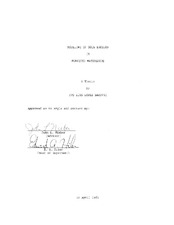| dc.description.abstract | The Universal Soil Loss Equation (USLE) predicts soil erosion by water. It has factors that take into account the climatic, the physical, and the topographical characteristics of an area. Among these factors are the crop management (C) and the conservation practice (P) factors, which are not tabulated for forest sites. This two factors may be quantified as a combined CP factor by using the USLE together with the measured soil losses over a year.
Once the CP factors are known, the Modified Universal Soil Loss Equation may be used to predict soil losses that are caused by single rainfall storm events. This may then be used as a managerial tool to evaluate the major factors controlling erosion in forests. Any action may be taken from this point to preserve the water quality of the streams leaving the forests. For example, detention or filtration ponds may be designed to control runoff water, if there is the economical incentive.
The calculation of a CP factor to represent a forest site and certain treatment conditions enables an evaluation of the site preparations practiced. For three watersheds that were sheared and windrowed, the CP average value found is 0.0014156 for 1981. While for three watersheds that received the roller chopped treatment, the CP value obtained is of 0.00003577 also for 1981. This means that the latter treatment resulted in lower soil losses.
As time advances from the period of treatment, the differences between treatments diminish, resulting in CP factors that are closer together. For 1984, the sheared and windrowed watersheds averaged a CP value of 0.0001368, while the roller chopped gave a value of 0.0000243. This both treatments compared to the lower values resulting from the control watersheds.
When more CP factor values are obtained through research, they may be used in tabular form, as the existing data for agricultural areas, for the practical prediction of soil losses in places where these are not measured directly. Quantified CP factors may then be used when similar forest site preparations are practiced. The CP factor may be used to predict annual soil losses with the Universal Soil Loss Equation or single storm soil erosion with the Modified Universal Soil Loss Equation. Even though more attention is given to the CP factor in this paper, carefull evaluation of the other factors is very important to be able to predict soil losses accurately. | en |


